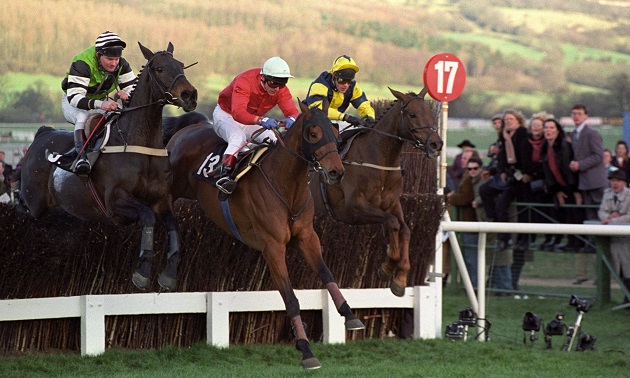Those who plunged on The Fellow for the 1993 Cheltenham Gold Cup, for which he started one of the most heavily-backed favourites in the history of the race, were a year too early. The betting public forsook The Fellow in the latest Gold Cup and, after being second favourite to the short-priced Jodami in the ante-post betting and opening at 5/1 on the course, he drifted out to 8/1 before closing 7/1 third favourite. Truth to tell, it seemed that The Fellow’s time had passed. He’d been beaten in the three previous Gold Cups—coming fourth to Jodami in 1993 after going down by a short head two years in a row—and came into the latest edition with eight successive defeats behind him.
The Fellow’s last victory had been in the 1992 King George VI Chase. Returned to Kempton in December in search of a third victory in the King George, The Fellow was equipped with blinkers for the first time in Britain (he’d worn them earlier in the season in France and was to wear them in all his subsequent races). He was already held by Barton Bank and Bradbury Star when making an uncharacteristic mistake at the last, and crossed the line a ten-length third. The Fellow did a little better in the Racing Post Chase at Kempton in February on his only outing between the King George and the Gold Cup. Carrying top weight of 11-13, and conceding between 5 lb and 27 lb to a very useful field, The Fellow started a well-backed favourite and came a creditable third to Antonin and Docklands Express. A high-class performance, but one that The Fellow would have to improve on to win the Gold Cup.
While The Fellow’s star seemed to be fading, Jodami’s seemed to be ascending again after a season that hadn’t gone so smoothly for him as the previous one. Jodami’s impressive victory in the Hennessy Cognac Gold Cup at Leopardstown on his last appearance before Cheltenham strengthened his position as Gold Cup favourite. The King George runner-up Bradbury Star displaced The Fellow as second favourite in a fifteen-strong field which also included the King George fourth Young Hustler, and two of the best Irish staying chasers, the Hennessy Cognac Gold Cup runner-up Deep Bramble and Flashing Steel who’d been alongside Jodami when coming to grief two out in that race.
The Fellow had been ridden closer to the pace than usual in both his races at Kempton and Adam Kondrat kept him in touch from the start in the Gold Cup. There was never a time during the race, which was run at a sound gallop, when The Fellow looked in trouble or made the semblance of a mistake, or when his rider looked anxious. At the second last he was alongside the leader Young Hustler, still travelling smoothly, with Jodami stalking the pair. The three were in line at the last where The Fellow produced the best jump to take the initiative. Jodami didn’t meet it so well and, though keeping on strongly, never really looked like getting back on the run-in. Kondrat was not going to be denied this time and picked up his stick in the closing stages to drive out The Fellow for a length-and-a-half victory over Jodami. Young Hustler came four lengths further back in third, with Flashing Steel and Bradbury Star fourth and fifth, ahead of the consistent Docklands Express who filled the position he’d occupied the previous year, finishing fractionally closer to the winner this time.
The Fellow’s victory was just reward for his toughness and for his connections’ perseverance, and those who argued afterwards that Jodami was unlucky might perhaps reflect on the post-race quite of Jodami’s jockey Mark Dwyer: ‘He was always travelling second best in the race and finished second’.
The Fellow’s jockey has been the butt of unfair criticism in some quarters over the seasons but he couldn’t have ridden a finer or more confident race. ‘There are good people and bad people, but when something bad is said about you, you try to do better,’ said Kondrat afterwards, adding that the margin of defeat had been so narrow on the two occasions he’d been second that he felt he was winning the race for the third time. ‘The Marquesa does not like her horses hit and I always think of this when I go out to ride,’ Kondrat added, ‘but after the last I was only thinking of winning and used my whip five or six times. The Fellow responded every time’. The Fellow’s trainer Francois Doumen is firmly established at the top of his profession and deserves tremendous credit for producing The Fellow in tip-top form on the day that mattered most. ‘I aimed more at the Gold Cup this year and less at the King George,’ said Doumen, ‘but then again The Fellow may be a bit better this time too, because a year ago my horses were running a bit below their best with some virus.’
Doumen is a rare exception among French jumping trainers in running his horses in Britain. The reason more don’t come isn’t hard to find: prize money is significantly higher in France. The Fellow was, in fact, the first French-trained horse to win the Cheltenham Gold Cup. He was the first French-bred to win since Mandarin, who, coincidentally, was broken in by Doumen’s father before joining Fulke Walwyn for whom he also won a King George VI Chase and a Grand Steeple-Chase de Paris. Mandarin’s victory over the best of the French-trained staying chasers in the Grand Steeple-Chase earned him a place among jumping’s immortals; the horse’s rubber bit broke after three fences and from then on Fred Winter was virtually unable to steer him, an exceptional display of horsemanship coupled with Mandarin’s courage being rewarded with a famous narrow victory.
When The Fellow won at Cheltenham, he emulated Mandarin’s achievement of winning the most important steeplechase in France—The Fellow won the Grand Steeple-Chase as a six-year-old—and the two most prestigious weight-for-age steeplechases in Britain. The Fellow’s Gold Cup victory earned him the National Hunt Horse of the Year award, the first time it has been won by a horse trained outside the British Isles. He received ten of the twenty-one votes cast by the press selection committee, the others going to Danoli (five), Viking Flagship (two), Flakey Dove (two), Miinnehoma and Mysilv.






















.jpg)


 Url copied to clipboard.
Url copied to clipboard.


.jpg&w=300)

.jpg&w=300)

.jpg&w=300)



























